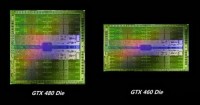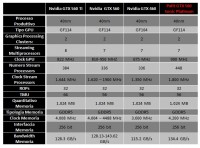FERMI architecture and GF114:
Nvidia has dedicated itself in a very meticulous way to the mainstream video cards market, where consumers usually try to optimally balance the price performance ratio. Just with the GF104 chips Nvidia has achieved this goal. Compared to the GF100, the GF104, and conseguently GF114, graphics chip architecture was redesigned, even if it is also based on the basic common concept of Graphics Processing Clusters (GPC), each consisting of Streaming Multiprocessor (SM).
(GF110 and GF114 chip comparison, versions with all SM enabled)
The Nvidia GF114 chip has a die size of 332 square millimeters, with 1.95 billion transistors and is built using 40nm production technology of Taiwan TSMC foundries. This chip has full support for Microsoft DX11 latest libraries, with 48 CUDA cores, 4 dispatch units and 8 texture units for each SM. Also the GF104 graphics chip has originally 8 SM, but Nvidia opted to enable only 7, in fact, turning one off.This was initially done to maximize yields, to have a greater number of usable chips during the production in the foundries.
In addition, even the not well performing chips, where an SM does not work, were comfortably used by different manufacturers to equip their GeForce GTX460. With the improvement of yields in the 40nm production process it has been possible ensuring increasing number of chips that work with all the 8 SM, so Nvidia, thanks to a new advanced step has been able to churn out chips that have been fully functional equipping the GeForce GTX 560 Ti.
The remainder of the chips defective in the SM were re-used again. The first reason is certainly the reuse of these chips that are not perfect, while the second reason is to cover the hole in the range of performance of the GTX 500 series, where there is an abnormal jump between the GeForce GTX 550 Ti and GTX 560 Ti.
With the introduction of the GeForce GTX 560 without the "Ti" suffix Nvidia is filling exactly this gap.
(The GF114 graphics chip in the final version)
Considering Nvidia GF114 chip in its entirety, in fact it has 2 Graphics Processing Clusters (GPC), each of which has 4 SM for a total of 8 SM. Unlike GF100, where each SM is characterized by 32 Cuda Core, GF104 integrates 48 Cuda Core for each SM, so the GF104 is composed of a maximum of 384 CUDA Core, 64 texture units and 8 PolyMorph engines. But as we said, Nvidia has disabled an SM in one of the two GPC, in this way we have actually 7 working SM and one disabled going to equip the standard version of the GTX 560. So we find 336 CUDA Core, 56 texture units and seven PolyMorph engines.
The PolyMorph Engine unit is responsible for Vertex Fetch, Tessellation, Viewport Transform, Attribute Setup, Stream Output operations and within it there is also the Tessellator unit. In the Fermi architecture the double precision floating point processing power is much higher than the previous architectures and has a value equal to half compared to when code is executed in single precision.
The Nvidia GeForce GF114 chip is currently used in two types of graphics cards that differ in some characteristics. Summarized in the table below the main features of the GF114 chip and of the video card produced by Palit:







